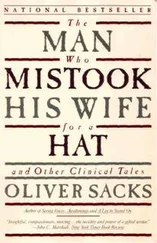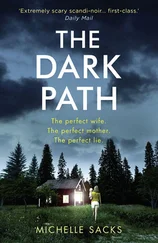When the epileptic focus lies at higher levels of the sensory cortex, in the parietal or the temporal lobes, the epileptic hallucinations may be much more complex. Valerie L., a gifted twenty-eight-year-old doctor, had what were called “migraines” from an early age — one-sided headaches preceded by twinkling blue dots. But when she was fifteen, she had a new, unprecedented experience. She said, “I had run a ten-mile race the day before … the next day I felt very strange.… I had a six-hour nap after a full night of sleep, which was most atypical for me, and then I went to temple with my family: it was a long service, a lot of standing.” She started to see halos around objects and said to her sister, “Something weird is happening.” And then a glass of water at which she was looking suddenly “multiplied itself,” so that she saw glasses of water wherever she looked, dozens of them, covering the walls and the ceiling. This went on for perhaps five seconds, “the longest five seconds of my life,” she said.
Then she lost consciousness. She came to in an ambulance, hearing the driver say, “I have a fifteen-year-old girl with a seizure,” and then realized with a start that she was the girl.
When she was sixteen, she had a second, similar attack and was put on antiepileptic medication for the first time.
A third grand mal seizure occurred a year later. Valerie saw vague black shapes in the air (“like Rorschach ink blots”), and as she continued to look, these transformed themselves into faces — her mother’s face and the faces of other relatives. The faces were motionless, flat, two-dimensional, and “like negatives,” so that light-skinned faces were seen as dark, and vice versa. They had wavering edges, “as if enveloped in flame,” in the thirty seconds before she had a convulsion and lost consciousness. After this, her doctors changed her antiepileptic medication, and she has had no more grand mal seizures since, though she continues to get visual auras or visual seizures, on average twice a month, more if she is stressed or sleep-deprived.
On one occasion, when Valerie was in college, she felt weak and not quite herself, so she went to her parents’ house for the evening. She and her mother were sitting and talking as Valerie lay in bed, when she suddenly “saw” e-mails she had received earlier in the day plastered all over her bedroom. One particular e-mail was multiplied, and one of its images was superimposed on her mother’s face, although she could see the face through it. The image of the e-mail was so clear and exact that she could read every word. Objects from her dorm room appeared everywhere she looked. It was a particular object, whether perceived or remembered, that got multiplied, never a whole scene. Her visual multiplications and reiterations are now of familiar faces for the most part, “projected” onto the walls, the ceiling, any available surface. This sort of spreading of visual perceptions in space (polyopia) and in time (palinopsia) was vividly described by Macdonald Critchley, who first used the term palinopsia (he originally called it paliopsia).
Valerie may also experience perceptual changes in relation to her seizures; indeed, her first intimation of a seizure is sometimes that her own reflection looks different — her eyes, in particular. She may feel, “This is not me,” or “It’s a close relative.” If she can go to sleep, she can avert a seizure. But if she has not been able to sleep well, other people’s faces may also look different the next morning — “strange” and distorted, especially around the eyes, though not so much that they are unrecognizable. Between attacks, she may have the opposite feeling — a hyperfamiliarity, so that everyone seems familiar to her. It is a feeling so overwhelming that sometimes she cannot resist greeting a stranger, even though, intellectually, she can say to herself, “This is just an illusion. It seems most unlikely that I have ever met this person.”
Despite her epileptic auras, Valerie lives a full and productive life, keeping up with a demanding career. She is reassured by three things: that she has not had a generalized seizure for ten years, that whatever is provoking her attacks is not progressive (she had a minor head injury when she was twelve and probably has a small temporal lobe scar from that injury), and that medication can provide adequate control.
Both Jen and Valerie were initially misdiagnosed as having “migraine” — such confusion of epilepsy and migraine is not uncommon. Gowers was at pains to differentiate them in his 1907 book, The Border-land of Epilepsy , and his lucid descriptions bring out some of the differences between the two ailments as well as some of the similarities. Both migraine and epilepsy are paroxysmal — they present themselves suddenly, go through their course, and then disappear. Both show a slow movement or “march” of symptoms and the electrical disturbance underlying them — in migraine this takes fifteen or twenty minutes; in epilepsy it is often just a matter of seconds. It is unusual for people with migraine to have complex hallucinations, whereas epilepsy commonly affects higher parts of the brain; there it may evoke very complex, multisensorial “reminiscences” or dreamlike fantasies, like one of Gowers’s patients, who saw “London in ruins, herself the sole spectator of this desolate scene.”
Laura M., a psychology major in college, at first ignored her “strange attacks” but finally consulted an epilepsy specialist, who found that she was “experiencing stereotypic episodes of déjà vu, visual and emotional flashbacks of a dream or series of dreams, usually one of five dreams … which she had in the past ten years.” These could happen several times daily and were aggravated by tiredness or by marijuana. When she started taking an antiepileptic medication, her attacks decreased in severity and frequency, but she had increasingly unacceptable side effects — in particular, a feeling of overstimulation followed by a “crash” later in the day. She took herself off the medication and reduced her use of marijuana, and now her attacks are at a tolerable level, perhaps half a dozen per month. They last only a few seconds, and although the internal feeling is overwhelming and she may “zone out” a little, others might not notice anything amiss. The only physical symptom she feels during these attacks is an impulse to roll her eyeballs back, which she resists when others are around.
When I met Laura, she said she had always had vivid, richly colored dreams that she could easily remember, and she characterized most of them as “geographic,” involving complex landscapes. She felt that the visual hallucinations or flashbacks she had in her seizures all drew on the landscapes of those dreams.
One such dreamscape was Chicago, where she lived as a teenager. Most of her seizures transported her to this dream Chicago — she has drawn maps of it, which contain actual landmarks, but in which the topography is strangely transformed. Other dreamscapes center around the hill in another city, where her university is situated. “For a few seconds,” she told me, “I flash back to a dream I have had, into the world of that dream, being in a different time and place. The places are ‘familiar,’ but don’t really exist.”
Another dreamscape, often reexperienced in seizures, is a transformed version of a hill town in Italy where she lived for a while. There is another, frightening one: “I’m with my little sister, on some sort of beach. We’re being bombed. And I lose her.… People are being killed.” Sometimes, she says, the dreamscapes blend together, a hill somehow turning into a beach. There are always strong emotional components — fear or excitement, usually — and these emotions can dominate her for fifteen minutes or so after the actual attack.
Читать дальше












